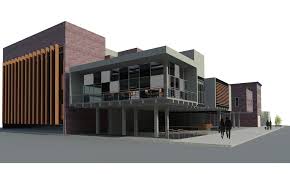• Getting Started
1. Introduction to for Autodesk Revit Architecture .
2. Starting Revit
3. Starting Revit for the First Time
4. Opening a Project File
5. Identifying the User Interface Components
6. Understanding the Ribbon
7. Understanding the Options Bar
8. Understanding the Application Menu
9. Understanding the Info Center Toolbar
10. Understanding the View Controls
11. Starting a New Project
• Modeling Essentials
1. Understanding Modeling with Revit
2. Understanding Model Objects
3. Understanding Sketch-Based Objects
4.Understanding Datum Elements
5.Creating and Modifying Levels
6.Creating and Modifying Grids
7.Segment Grids
8. Controlling Datum Visibility
9. Limiting Visibility of Datum Using Scope Boxes
10. Setting and Showing the Active Work Plane
11. Creating Reference Planes
12. Modeling Accurately with Length and Angle Snap Increments
13. Working with Object Snaps
14.Using Visualization Aids When Working in 3D Views
• Building elements
1. Wall Drawing Aids
2.Exterior Building Walls
3.Doors
4.Windows
5.Curtain Walls
6.Roofs
• Walls Systems
1. Wall System Families
2. Curtain Wall Types
3. Curved Curtain Wall
4. Curtain Walls that Turn Corners
5.Curtain Wall Grids
6. Curtain Wall Components
7.Stacked Wall
8. Wall Profiles
9. Wall Openings
10. Embedded Walls
11.In-Place Wall Sweeps
12.In-Place Reveals
13.Joined Walls for Complex Assemblies
• Building Core
1. Building Core Walls
2. Floors
3. Hosted Components
4. Architectural Columns
5. Stairs
6. Landing Components
7. Support Components
8. Ramps
9. Railings
• Building Interiors
1. Interior Partitions
2. Interior Storefront Glazing
3. Rooms
4. Ceilings
5. Area Plans
• Components and Families
1.Understanding Families
2.Loading Families and Using Type Catalogs
3.Editing Component Families Within a Project
4.Placing Components from the Project Browser
• Basic Modify and Reporting Tools
1. Selecting Objects
2.Saving Selection Sets
3.Copying and Moving Objects
4.Rotating Objects
5.Creating Linear Arrays
6.Creating Radial Arrays
7.Scaling Objects
8.Mirroring Objects
9.Using the Clipboard for Copy And Paste
10.Splitting Objects
11.Creating Elements Consistently with Match Type Properties and Create Similar
12. Aligning Objects
13. Trimming and Extending Objects
14. Offsetting Objects
15. Pinning Objects in Place
16.Deleting Objects
17. Dimensioning Objects
18.Understanding Element IDs
19.Understanding and Reviewing Warning Messages
20.Reporting and Displaying Coordinates
• Views and Sheets
1. Creating Plan Views and Reflected Ceiling Plan Views
2. Creating a Plan Region
3. Creating Building Elevation Views
4. Creating Interior Elevation Views
5. Creating Framing Elevation Views
6. Creating Section Views
7. Segmenting a Section View
8. Creating Callout Views
9. Creating Drafting Views
10. Creating a Reference View
11. Understanding View Discipline
12. Duplicating Views
13. Creating Match lines and View References
14. Creating Additional View References
15. Creating and Using Sheets
16. Aligning Views on Sheets with a Guide Grid
17. Placing Schedules on a Sheet
18. Using a Sheet List and Placeholder Sheets
19. Creating Custom Title blocks
20. Creating a Key Plan
21. Managing Sheet Issues and Revisions
22. Creating Revision Clouds and Tags
23. Adding a Revision Schedule to a Title block
24. Creating Supplemental Drawings
• Graphics and visual representations
1. Working with Visual Styles
2. Understanding Scale and Detail Level
3. Understanding Plan View Range
4. Understanding View Templates
5. Creating View Templates
6. Applying and Assigning View Templates
7. Creating View Types
8. Understanding Object Styles
9. Understanding Visibility and Graphic Overrides
10. Creating Element and Category
11. Graphic Overrides in a View
12. Creating Filter Overrides
13. Understanding Temporary Hide or Isolate and Viewing Hidden Elements
14. Understanding Crop Regions
15. Understanding Annotation Crop Regions
• Dimensions and Constraints
1.Understanding Dimensions and Constraints
2.Using Temporary Dimensions
3.Modifying Temporary Dimension Settings
4.Working with Permanent Dimensions
5.Working with Spot Elevations
6.Working with Spot Coordinates
7.Working with Spot Slopes
8.Modifying Dimensions
9.Overriding Dimension Text
10.Creating and Modifying Dimension Styles
11.Locking Dimensions
12.Controlling Dimensions Using Equality Constraints
13.Controlling Dimension Units
14.Dimensioning Entire Walls
• Site Tools
1.Introduction to the Site Tools
2.Creating a Topo surface Using Points
3.Creating a Topo surface from CAD
4.Creating a Topo surface from a Points File
5.Managing Site Settings
6.Creating Topo surface Sub-regions and Split Surfaces
7.Creating Building Pads
8.Creating a Graded Region
9.Creating Site and Parking Components
• Conceptual Mass Design
1.Understanding the Conceptual Design Environment
2.Working in 3D in the Conceptual Design Environment
3.Creating Conceptual Mass Solid Forms
4.Creating Conceptual Mass Surfaces
5.Creating Conceptual Mass Void Forms
6.Creating Reference Planes and Reference Lines
7.Lines versus Reference Lines
8.Using Reference Points
9.Creating Dimension and Parameter Constraints
10.Modifying Form Profiles
11.Modifying Forms with Add Edge And Add Profile
12.Sketching on Forms
13.Creating Divided Paths
14.Creating Divided Surfaces
15.Adding Patterns to Divided Surfaces
16.Creating a Panel Family for Conceptual Massing
17.Creating Adaptive Components
18.Loading a Conceptual Mass
19.Into the Project Environment
20.Conceptual Massing in Projects
21.Understanding How to Place Masses and Control Their Visibility
22.Creating an In-Place Mass
23.Creating Masses with 3D CAD Files
24.Creating Mass Floors
25.Working with Mass Type
26.Properties to Place Tags and
27.Create Schedules
28.Creating Model by Face Elements
29.Modifying Elements with Update To Face and Edit Face Selection
• Design Analysis
1. Sun Path Diagram
2. Solar Study
3. Energy Analysis
• Schedules and Tags
1.Understanding Schedules and Tags
2.Placing Element Tags by Category
3.Placing Room and Area Tags
4.Creating a Schedule and
5.Specifying Fields
6.Modifying Schedules with Filters
7.Modifying Schedules with Sorting and Grouping
8.Modifying Schedule Formatting

